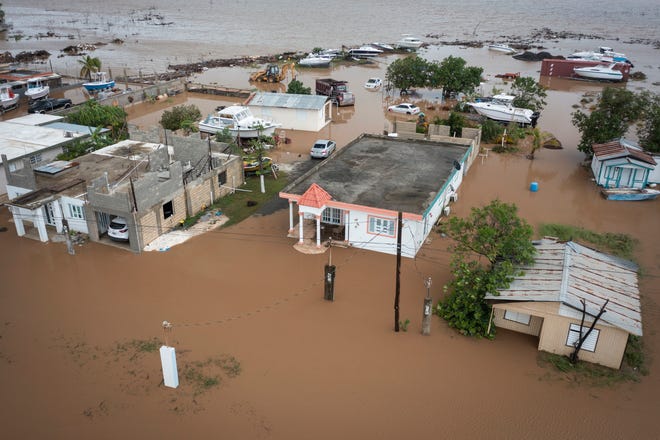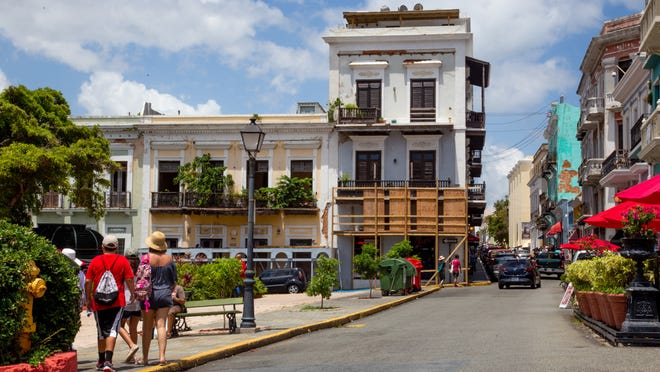- Some Puerto Ricans are worried Hurricane Fiona recovery aid won’t be distributed fairly to communities across the island.
- “We had Hurricane Maria five years ago, and we saw how structural racism and inequities put our most vulnerable communities in danger,” said one resident. “But now we’re seeing it all happen again.”
- Recent policy changes reflect lessons learned from Hurricane Maria. Compared to that storm, more than 100,000 more survivors have received aid so far after Fiona, a FEMA spokesperson said.
Weeks after Hurricane Fiona hit Puerto Rico, floodwaters have mostly receded in the hard-hit town of Loíza, but mud, debris and collapsed roofs remain. Power has been restored in some areas but is still unstable.
“Families have lost everything,” said Gloriann Sacha Antonetty Lebrón, founder of Revista Étnica, Puerto Rico’s first magazine for Black women and a leader of a mutual aid operation providing support to Loíza.
Yet when President Joe Biden initially approved an emergency declaration after the hurricane, Loíza and many other hard-hit communities were not included, experts told USA TODAY. The exclusion prompted concerns that the recovery effort will once again leave behind some of Puerto Rico’s poorest areas five years after those same communities struggled to receive federal and local disaster aid when Hurricane Maria pummeled the U.S. territory.
The Hurricane Fiona emergency declaration originally included 55 municipalities, according to the Federal Emergency Management Agency. In the days after the disaster, communities were added to the declaration until the most recent version included all 78 municipalities, including Loíza.
The initial disaster declaration was “based on the available data and assessments at the time,” Jeremy Edwards, the agency’s press secretary, said in a statement to USA TODAY. “The intent was to get resources to survivors as quickly as possible. As the assessments continued and were completed, additional municipalities were added.”
But among many communities initially excluded, there is still a feeling of being left behind that builds on the trauma of Hurricane Maria, experts said.
“We had Hurricane Maria five years ago, and we saw how structural racism and inequities put our most vulnerable communities in danger,” Lebrón said. “But now we’re seeing it all happen again.”
GRAPHICS:See the scope of Hurricane Fiona’s damage in Puerto Rico in charts and graphics
What happened after Hurricane Maria?
For many Puerto Ricans, Hurricane Fiona was a grim reminder of the disaster that struck five years before when Hurricane Maria, the deadliest natural disaster on the island in 100 years, left about 3,000 people dead and shattered the country’s electrical system.
While parts of the San Juan metropolitan area had power within days of the hurricane, many communities, often more rural and poorer municipalities, waited more than 300 days for power restoration crews to be sent to their communities, said Fernando Tormos-Aponte, assistant professor of sociology at the University of Pittsburgh.
Tormos-Aponte’s research, based on power restoration data and published in the journal Energy Policy last year, found that vulnerable communities and communities that were not as supportive of Puerto Rico’s governing party in previous elections were significantly less likely to be prioritized in relief efforts. The study used a social vulnerability index from the Centers for Disease Control and Prevention based on factors including poverty levels and minority status.
TOURISM IN PUERTO RICO:Puerto Rico crippled with closures and outages post-Fiona. What travelers can expect
The study found the more affluent Condado in San Juan had power restored in less than 40 days, while the nearby Luis Lloréns Torres public housing project waited more than 100 days. And about 62% of the municipalities that went more than 150 days before power restoration crews were deployed to them were municipalities that did not support the governing party in the previous election.
“These systems that govern how we respond to disasters can be unequal by design and they tend to exclude marginalized communities, to neglect them,” said Tormos-Aponte, who moved to the mainland United States from Puerto Rico in 2011.
There are “major discrepancies in the way Puerto Rico has prioritized the response to Maria and Fiona,” said Miguel O. Román, a climate scientist with research company Leidos based in Virginia who uses satellite images to spot persistent power outages.
Román’s research shows rural and poorer municipalities shouldered the longest outages after Hurricane Maria. He said first responders arriving in Puerto Rico start by settling in crisis centers that are concentrated in the island’s wealthier tourist centers.
“Looking at what happened after Hurricane Maria and the inequities that existed can help us understand how different degrees of damage impacts specific communities and what the needs are for different communities,” Román said. “We need to learn from Hurricane Maria.”
National research has shown disasters often exacerbate existing disparities marginalized communities face and “have more lasting impacts on communities that were disadvantaged prior to the disaster,” according to a 2022 report by the U.S. Commission on Civil Rights, which reviewed federal responses to Hurricanes Harvey and Maria.
‘A TERRIBLE CYCLE’:Hurricane Fiona, natural disasters expose mental health crisis in Puerto Rico
A reason cited by the report is that damage assessments are based on property ownership, which leads to concentrating federal resources in wealthier areas, said Kathleen Tierney, a research professor at the Institute of Behavioral Science at the University of Colorado Boulder. Disaster aid also typically makes up a small proportion of the funds needed for individual recovery and the remaining funding comes from loans that are “extremely burdensome and difficult to access,” she said.
Puerto Rico has little political representation on mainland U.S., which makes it more vulnerable to being sidelined, Tierney said.
As a result, federal disaster aid “is wholly inadequate in terms of recovery,” she said.
Repeating history in Puerto Rico?
There are already signs history is repeating itself, Tormos-Aponte said. In the initial emergency declaration, nine of the excluded municipalities – Hormigueros, San Sebastian, Moca, Rincon, Aguaba, Isabela, Quebradillas, Hatillo, Barceloneta – were also those with the highest levels of social vulnerability on the island, he said. Many of them also were led by opposition party leaders.
Román said he immediately thought of his grandmother in Hormigueros when the first declaration was released.
‘WE OWE PUERTO RICO A HELL OF A LOT’:Biden visits to assess Fiona recovery efforts
“Her home was underwater, but her community was not included in the first declaration,” he said.
FEMA has since mobilized more than 30 disaster recovery centers on the island, including in Rincon, Isabela and Barceloneta, Edwards said. He said the agency collects data to determine what communities may be most vulnerable, including low-income populations and people 65 and older.
In addition, hundreds of FEMA representatives going door to door to help survivors apply for assistance have visited all Puerto Rican municipalities, he said.
Edwards said these efforts and recent policy changes meant to expand criteria for aid eligibility and simplify eligibility verification processes for people seeking aid reflect lessons learned from Hurricane Maria. Compared with Maria, more than 100,000 more survivors have received aid so far after Fiona, he said.
“FEMA remains committed to helping survivors recover from Hurricane Fiona in Puerto Rico, ensuring that they have equal access to our programs and that the federal disaster assistance process is more accessible,” he told USA TODAY.
Román applauded the efforts and expressed hope that FEMA under President Joe Biden’s administration has made progress in addressing equity in aid response, though more work is needed.
Despite some improvements since past disasters, Elvia Meléndez-Ackerman, professor of environmental sciences at the University of Puerto Rico, said low-income, rural and minority communities in Puerto Rico are once again being left behind in crisis response, leading many to leave Puerto Rico altogether. She said that of the University of Puerto Rico’s 11 campuses, three are in cities initially excluded but were among the hardest-hit. All three are also governed by opposing parties, she said.
“Some communities are being emptied out,” she said. “Many are buying plane tickets and leaving. And those that stay, they are left to repair their homes with little help.”
EFFECT ON SCHOOLS:Puerto Rico’s schools struggled long before Hurricane Fiona. Now they need more help
‘It sends a message that some lives don’t matter’
Loíza, a town on the island’s northeastern coast known for its African heritage and for having one of the largest Black populations on the island, is “a snapshot” of these inequities, said Tania Rosario-Méndez, executive director of Taller Salud Inc., a feminist social justice advocacy organization supporting grassroots aid in the area.
Rosario-Méndez said Puerto Rico’s poor, rural and Afro-Latino communities are bearing the brunt of the crisis without adequate aid. She said Loíza’s initial exclusion from the declaration was an early sign the town, with roofs still covered with blue tarps from Hurricane Maria, may be left behind again.
“The shock of having your home 5 feet underwater and then seeing that your community isn’t even listed on the disaster declaration – that hits you,” she said. “It was violent. I can’t express the shock.”
She is thankful the declaration was amended, “but that feeling still lingers,” especially after local governments and organizations had to fight to prove they needed aid amid an unfolding crisis, she said.
“You realize that if you don’t fight, you lose the possibility of surviving in a dignified manner. … It sends a message that some lives don’t matter,” she said.
In the first week after Hurricane Fiona, Lebrón of Revista Étnica said she only saw one FEMA truck in Loíza. As a result, Lebrón said, neighbors and community groups are working together to fill in the gaps, creating mutual aid networks to help rebuild homes, repair water damage and share food.
“We’re doing this work because governments have not been here for these communities,” Lebrón said.
How can disaster relief be improved?
To better protect vulnerable communities after disasters, experts told USA TODAY, utility companies and governments should move away from prioritizing power restoration based on only how densely populated an area is. Authorities should identify the most vulnerable communities as priorities for power restoration, they said.
PUERTO RICO INDEPENDENCE EFFORTS:After Hurricane Fiona, will Puerto Rico ever become a state or an independent nation?
“The problem with that is that utility officials usually don’t take into consideration race, gender, ethnicity, class and economics,” Tormos-Aponte said. “By virtue of ignoring these things and using only the density-based approach, they may be reproducing inequalities that already exist.”
Other steps include changing the federal aid application process to be less burdensome for municipalities already struggling during a crisis and more accessible to areas without ready access to internet and Spanish-speaking communities. More data transparency and long-term data collection on how aid is allocated, especially among marginalized communities, also would make a difference, experts said.
“It’s a matter of life or death,” Lebrón said. “We all deserve the opportunity to live in wellness and dignity. Our people deserve better.”
Contact Christine Fernando at cfernando@usatoday.com or follow her on Twitter at @christinetfern.



